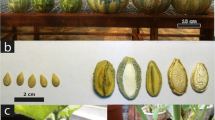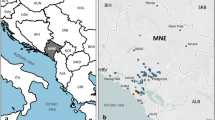Abstract
Eastern North America is one of at least six regions of the world where agriculture is thought to have arisen wholly independently1,2,3,4,5. The primary evidence for this hypothesis derives from morphological changes in the archaeobotanical record of three important crops—squash, goosefoot and sunflower—as well as an extinct minor cultigen, sumpweed1,3. However, the geographical origins of two of the three primary domesticates—squash and goosefoot—are now debated6,7, and until recently sunflower (Helianthus annuus L.) has been considered the only undisputed eastern North American domesticate. The discovery of 4,000-year-old domesticated sunflower remains from San Andrés, Tabasco8,9, implies an earlier and possibly independent origin of domestication in Mexico and has stimulated a re-examination of the geographical origin of domesticated sunflower. Here we describe the genetic relationships and pattern of genetic drift between extant domesticated strains and wild populations collected from throughout the USA and Mexico. We show that extant domesticates arose in eastern North America, with a substantial genetic bottleneck10 occurring during domestication.
This is a preview of subscription content, access via your institution
Access options
Subscribe to this journal
Receive 51 print issues and online access
$199.00 per year
only $3.90 per issue
Buy this article
- Purchase on Springer Link
- Instant access to full article PDF
Prices may be subject to local taxes which are calculated during checkout



Similar content being viewed by others
References
Smith, B. D. Origins of agriculture in eastern North America. Science 246, 1566–1571 (1989)
Cowan, C. W. & Watson, P. J. in The Origins of Agriculture: An International Perspective (eds Cowan, C. W. & Watson, P. J.) 207–212 (Smithsonian Institution Press, Washington DC/London, 1992)
Smith, B. D. Rivers of Change: Essays on Early Agriculture in Eastern North America (Smithsonian Institution Press, Washington DC/London, 2002)
Diamond, J. Evolution, consequences and future of plant and animal domestication. Nature 418, 700–707 (2002)
Neumann, K. New Guinea: A cradle of agriculture. Science 301, 180–181 (2003)
Wilson, H. D. Quinua and relatives (Chenopodium sect. Chenopodium subsect. Cellulata). Econ. Bot. 44S, 92–110 (1990)
Sanjur, O. I., Piperno, D. R., Andres, T. C. & Wessel-Beaver, L. Phylogenetic relationships among domesticated and wild species of Cucurbita (Cucurbitaceae) inferred from a mitochondrial gene: Implications for crop plant evolution and areas of origin. Proc. Natl Acad. Sci. USA 99, 535–540 (2002)
Lentz, D. L., Pohl, M. E. D., Pope, K. O. & Wyatt, A. R. Prehistoric sunflower (Helianthus annuus L.) domestication in Mexico. Econ. Bot. 55, 370–376 (2001)
Pope, K. O. et al. Origin and environmental setting of ancient agriculture in the lowlands of Mesoamerica. Science 292, 1370–1373 (2001)
Tang, S. X. & Knapp, S. J. Microsatellites uncover extraordinary diversity in native American land races and wild populations of cultivated sunflower. Theor. Appl. Genet. 106, 990–1003 (2003)
Fritz, G. J. in People, Plants and Landscapes (ed. Gremillion, K. J.) 42–62 (Univ. Alabama Press, Tuscaloosa, Alabama, 1997)
Heiser, C. B. Jr, Smith, D. M., Clevenger, S. B. & Martin, W. C. Jr The North American sunflowers (Helianthus). Mem. Torr. Bot. Club 22, 1–218 (1969)
Heiser, C. B. Jr The sunflower among the North American Indians. Proc. Am. Phil. Soc. 95, 432–448 (1951)
Asch, D. L. Common sunflower (Helianthus annuus L.): the pathway toward its domestication. Proc. 58th Annu. Meeting 17 May 1993 (Society of American Archaeology, St Louis, Missouri)
Yarnell, R. A. in The Nature and Status of Ethnobotany in Eastern North America (ed. Ford, R. I.) 289–300 (Anthropological Papers No. 67, Museum of Anthropology, Univ. Michigan, Ann Arbor, 1993)
Heiser, C. B. Jr Variation and subspeciation in the common sunflower, Helianthus annuus. Am. Midl. Nat. 51, 287–305 (1954)
Rieseberg, L. H. & Seiler, G. Molecular evidence and the origin and development of the domesticated sunflower (Helianthus annuus). Econ. Bot. 44S, 79–91 (1990)
Arias, D. M. & Rieseberg, L. H. Genetic relationships among domesticated and wild sunflowers (Helianthus annuus, Asteraceae). Econ. Bot. 49, 239–248 (1995)
Cronn, R., Brothers, M., Klier, K., Bretting, P. K. & Wendel, J. F. Allozyme variation in domesticated annual sunflower and its wild relatives. Theor. Appl. Genet. 95, 532–545 (1997)
Pritchard, J. K., Stephens, M. & Donnelly, P. Inference of population structure using multilocus genotype data. Genetics 155, 945–959 (2000)
Falush, D., Stephens, M. & Pritchard, J. K. Inference of population structure using multilocus genotype data: linked loci and correlated allele frequencies. Genetics 164, 1567–1587 (2003)
Crites, G. D. Domesticated sunflower in fifth millennium B.P. temporal context: new evidence from middle Tennessee. Tenn. Am. Antiquity 58, 146–148 (1993)
Brewer, A. J. in Excavation of the Higgs and Doughty Sites I-25 Salvage Archaeology (eds McCollough, M. C. R. & Faulkner, C. H.) 141–144 (Miscellaneous Papers No. 12, Tennessee Archaeological Society, Knoxville, Tennessee, 1973)
Ota, T. DISPAN: Genetic Distance and Phylogenetic Analysis 〈http://www.bio.psu.edu/People/Faculty/Nei/Lab/Programs.html〉 (Institute of Molecular Evolutionary Genetics, Pennsylvania State Univ., 1993)
Goudet, J. FSTAT, a program to estimate and test gene diversities and fixation indices (version 2.9.3), 2001. Updated from Goudet, J. FSTAT (version 1.2): a computer program to calculate F-statistics. J. Hered. 86, 485–486 (1995)
McClung De Tapia, E. in The Origins of Agriculture: An International Perspective (eds Cowan, C. W. & Watson, P. J.) 144–145 (Smithsonian Institution Press, Washington DC/London, 1992)
Acknowledgements
We thank C. B. Heiser, Jr for advice throughout the course of this study and for reading an earlier version of the manuscript. We thank J. Pritchard for advice concerning implementation of the admixture model and A. Hwang and J. Durphy for assistance with the genotyping of the domesticates and Mexican populations, respectively. The analyses were made possible via access to the UNIX computing cluster provided by the University Information Technology Services department, Indiana University. This work was supported by grants from the NSF, the USDA and the National Geographic Society.
Author information
Authors and Affiliations
Corresponding author
Ethics declarations
Competing interests
The authors declare that they have no competing financial interests.
Supplementary information
Supplementary Methods
Provides details of the admixture model as implemented in population structure analysis of wild H. annuus and in the ancestry analysis of domesticated sunflower. Also provides details on methods employed to generate the neighbor-joining tree. (DOC 30 kb)
Supplementary Table 1
Provides information on collection localities. (DOC 36 kb)
Supplementary Table 2
Provides information on loci used in genotyping individuals. (DOC 33 kb)
Supplementary Table 3
Provides diversity measures for each wild population and domesticate strain as well as comparisons of extant diversity in wild H. annuus versus domesticated sunflower. (DOC 34 kb)
Supplementary Table 4
Provides all estimates of drift in each wild population versus each domesticate strain for all runs of the F model as well as the 90% credibility region around our estimates from the final run. (XLS 62 kb)
Supplementary Figure 1
Illustrates the estimated population structure in wild H. annuus for K = 2 clusters using the full data set. (PDF 227 kb)
Supplementary Figure 2
Illustrates the estimated population structure in wild H. annuus for K = 2 clusters using the subdivided data set. (PDF 228 kb)
Rights and permissions
About this article
Cite this article
Harter, A., Gardner, K., Falush, D. et al. Origin of extant domesticated sunflowers in eastern North America. Nature 430, 201–205 (2004). https://doi.org/10.1038/nature02710
Received:
Accepted:
Issue Date:
DOI: https://doi.org/10.1038/nature02710
This article is cited by
Comments
By submitting a comment you agree to abide by our Terms and Community Guidelines. If you find something abusive or that does not comply with our terms or guidelines please flag it as inappropriate.



